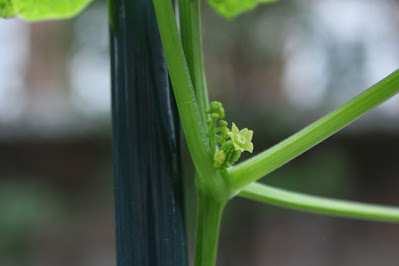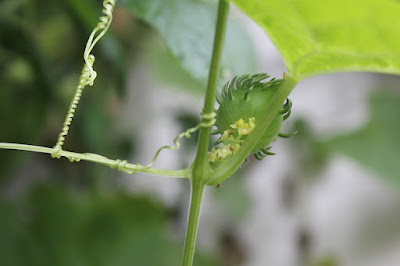The veg patch has definitely embraced winter - I managed an hour of clearing and tidying in the garden at the weekend before my hands needed to warm up around a mug of hot chocolate. I noticed that the branches of the fruit trees are now completely bare, in contrast to a couple of weeks ago when it was 'too soon to prune'.
 |
| (Taken on the day of Winter Solstice - so dark in the midday that I had to photograph in the bathroom!) |
This year I feel much better equipped to deal with pruning as I've received a copy of The Fruit Tree Handbook by Ben Pike. What I needed was a book that properly explained the how, why and wherefore of pruning and, in this book, I've got it. There's an entire chapter devoted to the subject: read this and the brain fog surrounding pruning will magically disperse. Every pair of secateurs sold should be accompanied by a copy of this chapter. For me, this is life-changing stuff and it's written in a really clear, logical way. No wonder I couldn't figure it out from a 2 page RHS handout - this one topic takes 22 pages to explain.
The author writes about the consequences of pruning lightly or hard, both immediate and long term, in producing both vegetative and fruiting growth. Terminology is clearly explained, supported by very good diagrams - laterals, sub-laterals, fruiting spurs, growth rings, leaf buds, one year old growth, two year old growth: all of these are now easily identified. Formative pruning, pruning techniques and a range of pruning tools are all comprehensively covered. And I now know the difference between tip bearing and spur bearing trees. And that's just the general skinny on pruning; information specific to each fruit is contained in later chapters.

The book is presented in four sections plus a glossary, appendices, resources and index; pruning falls into the section on Fruit Tree Management and is followed by a chapter on identifying, and organically controlling, pests and problems associated with fruit trees. Detailed information in the chapter reads like a medical dictionary for fruit, complete with graphic pictures that drive the point home. For me, this whole section would have been worth the cover price alone.
But there's so much more to this book. Ben is a man who is passionate about orchards (indeed, he's the Head Gardener at Sharpham Estate in Devon where he manages two orchards containing 150 fruit trees). So the third part of this book has separate chapters devoted to individual tree-grown fruits: apples, pears, plums, cherries, peaches & nectarines, apricots - and other fruit (figs, quinces, medlars, mulberries). You won't find shrub or cane fruit in here - we're talking
Orchards. Tables neatly set out the unique characteristics of each variety and are listed in order of their time of cropping: for example, I could pick Beauty of Bath in early August and, by growing a variety of apples, carry on picking fresh fruit through to late October with a Winston apple (sweet-sharp, aromatic and nutty). I had almost completed my preparations to buy more trees for the York Rise garden but this section had me tearing up my list after reading the recommendations for dessert and cooking apple varieties. Ben sensibly advocates taking some time to deliberate over the final choice to make sure that what you grow is right for your garden and your needs and for storage, if you so wish. This is not something we did when the York Rise mini-orchard went in 3 winters ago as we opted for well known varieties: conference pears, braeburn apples, morello cherries and victoria plums. I've realised that I now have an opportunity to broaden the scope of the 'orchard' here by growing some more interesting varieties such as Pitmaston Pineapple ("an old variety with crisp and nutty, small sweet yellow apples") or Lord Lambourne ("crisp, juicy flesh, sweet with balancing acidity").

Both the first and last sections (Planning and Planting an Orchard; Renovating an Orchard and Building a Community Orchard) are more probably targeted towards the professional fruit grower and of less interest to the amateur gardener who may only want to grow a few trees but that, in my opinion, does not detract from making this a useful reference book for both.
The book concentrates on growing fruit but doesn't tell you what to do with your fruit once picked; Ben Pike leaves that to other experts. This is a handbook that reflects the author's love for the environment and for fruit trees. What you do get here is a wealth of knowledge that will benefit the trees in your care - written in an easy, flowing style that makes the information easily accessible and memorable, even for a novice like me. This is the author on the principles of pruning:
"Pruning fruit trees is a subject that seems to be shrouded in mystery. Many people, not really knowing where to start, are afraid of damaging their trees [...]; it is possible to harm fruit trees, either by pruning too hard, or pruning at the wrong time of year, but clear instructions and an understanding of the principles of pruning will allow you to make judicious cuts that will help your trees to prosper."
If, like me, you have any doubts about what to do when faced with any tree or shrub to prune, I recommend you give this book a try. You'll be in safe hands. And if you are yet to contemplate growing your own fruit, this book may just motivate you to find a space for a couple of trees in your garden. As the author says, by growing your own orchard, or just a few trees, you can grow the kind of apple that is perfect for you - with the added advantage of creating a habitat for all kinds of wildlife.
My (very grateful) thanks to Stacey Hodge at
Green Books for sending the book.

























